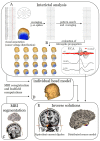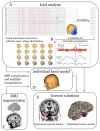Electric Source Imaging in Presurgical Evaluation of Epilepsy: An Inter-Analyser Agreement Study
- PMID: 36291992
- PMCID: PMC9601236
- DOI: 10.3390/diagnostics12102303
Electric Source Imaging in Presurgical Evaluation of Epilepsy: An Inter-Analyser Agreement Study
Abstract
Electric source imaging (ESI) estimates the cortical generator of the electroencephalography (EEG) signals recorded with scalp electrodes. ESI has gained increasing interest for the presurgical evaluation of patients with drug-resistant focal epilepsy. In spite of a standardised analysis pipeline, several aspects tailored to the individual patient involve subjective decisions of the expert performing the analysis, such as the selection of the analysed signals (interictal epileptiform discharges and seizures, identification of the onset epoch and time-point of the analysis). Our goal was to investigate the inter-analyser agreement of ESI in presurgical evaluations of epilepsy, using the same software and analysis pipeline. Six experts, of whom five had no previous experience in ESI, independently performed interictal and ictal ESI of 25 consecutive patients (17 temporal, 8 extratemporal) who underwent presurgical evaluation. The overall agreement among experts for the ESI methods was substantial (AC1 = 0.65; 95% CI: 0.59-0.71), and there was no significant difference between the methods. Our results suggest that using a standardised analysis pipeline, newly trained experts reach similar ESI solutions, calling for more standardisation in this emerging clinical application in neuroimaging.
Keywords: EEG; epilepsy; presurgical evaluation; source analysis; source imaging.
Conflict of interest statement
Dario Arnaldi: received fees from Fidia, Jazz and Lundbeck for lectures, consultation and board participation. All other authors declare no conflict of interest.
Figures




References
-
- Kwan P., Arzimanoglou A., Berg A.T., Brodie M.J., Allen Hauser W., Mathern G., Moshé S.L., Perucca E., Wiebe S., French J. Definition of drug resistant epilepsy: Consensus proposal by the ad hoc Task Force of the ILAE Commission on Therapeutic Strategies. Epilepsia. 2010;51:1069–1077. doi: 10.1111/j.1528-1167.2009.02397.x. - DOI - PubMed
LinkOut - more resources
Full Text Sources

